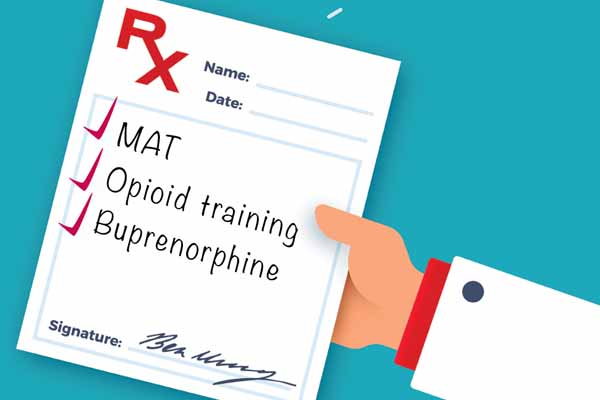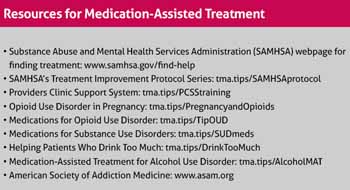
Austin addiction specialist Ann Marie Case, MD, frequently fields questions from other physicians about medication-assisted treatment (MAT), the combined use of medicines and counseling to treat people with substance use disorder.
Many of those questions are tinged with skepticism.
One of the biggest concerns fellow physicians have is that MAT just switches one addiction for another – such as using buprenorphine to treat addiction to another opioid.
“That’s a huge component of the stigma that I see among my colleagues when I get phone calls or get asked to consult,” Dr. Case said.
While the belief is unfounded, it’s understandable that physicians still think that way, says Michael Sprintz, DO, a Houston-area specialist in addiction medicine and pain medicine. Except for physicians who recently graduated from medical school, most had little or no training in those four years about how to handle a patient with a substance use disorder.
“As physicians, whenever we dive into a new area we haven’t been trained in, it brings a level of anxiety because our biggest concern is keeping our patient safe,” he said.
The widespread stigma against MAT also is based on a misunderstanding about the goal of treatment for substance use disorder, Dr. Sprintz says.
“The goal is not just chemical abstinence,” he said. “The primary goal is helping people develop self-awareness, skills, and tools to handle life on life’s terms – what I call ‘emotional sobriety.’… The value of medication-assisted treatment is that it helps people stick around in treatment, so they can learn all the other things that they need to learn about living a life without needing drugs or alcohol. MAT enables people to focus on something other than getting out of withdrawal or feeding an overwhelming craving that drives people to leave treatment early.”
But the stigma against medication-assisted treatment for opioid use disorder in particular means 86.6% of people who need this treatment are not getting it, according to a study published in the December 2022 International Journal of Drug Policy .
“Most of my patients know there’s a treatment from what they’ve heard on the street from other people, not from a health care professional,” Dr. Case said.
A better understanding of MAT – combined with recent changes in federal law about prescribing these medications and required physician education on the subject – will allow a much broader group of doctors not involved in addiction medicine not only to help tackle the opioid crisis but also to make sick people well again, Dr. Sprintz says.
“You’ll start to see what you couldn’t see before,” he said.
The medications for MAT are approved by the Food and Drug Administration (FDA) and extremely safe and effective, Dr. Case says. In fact, MAT is the best way to treat opioid use disorder and is now commonly referred to as MOUD, or medication for opioid use disorders.
“We know [MOUD] is the standard of care for opioid use disorder,” she said. “We’ve known that since the 1970s, and we’ve known that it works.”
MAT also can help patients combat the powerful addictions to alcohol and tobacco, says Austin addiction psychiatrist Carlos Tirado, MD, a member of TMA’s Subcommittee on Behavioral Health.
“[The medications] reduce heavy drinking and the medical problems associated with excessive alcohol use,” he said. “And it can help people reduce and quit smoking.”
The combination of medication and counseling used in MAT is not much different from treatments for other chronic diseases, Dr. Tirado says. For instance, treating diabetes requires medication as well as counseling for weight loss and physical activity while addressing emotional and socioeconomic concerns that affect the disease.
“In that way, [treating] substance use disorder is no different,” he said. “Psychosocial interventions, addressing comorbidities – be they physical or psychiatric – those are all part of what we call a plan of sustained recovery. It does require a comprehensive approach.”
The medications used in MAT normalize brain chemistry, relieve physiological cravings, and normalize body functions without the negative and euphoric effects of the substance used, according to the Substance Abuse and Mental Health Services Administration, a branch of the U.S. Department of Health and Human Services.
The medications fall into three broad categories, Dr. Tirado explains. Some, like buprenorphine, essentially replace a more harmful, highly addictive opioid, like heroin, with one that is longer acting and prevents physical withdrawal and craving but is much safer. Others, like naltrexone, are opioid antagonists that block the effect of the opioid or reduce the rewarding effect of alcohol. Still others create an adverse reaction to the addictive drug, the way disulfiram makes people sick after drinking alcohol, for instance.
As with many medicines, those used for MAT can be abused, Dr. Tirado says. But in the overwhelming number of cases, they’re not, and they have a great track record.
Several studies show that compared with no treatment or treatments not involving medications, MOUD decreases overdose risk with opioids by more than 50%. The three medications used for MOUD – methadone, buprenorphine, and extended-release naltrexone – are consistently associated with improved health outcomes, including reduced opioid use, transmission of HIV and hepatitis C, and overdose risk, according to the National Academies of Sciences, Engineering, and Medicine.
“They’re either more or as effective as other treatments applied to other chronic conditions,” Dr. Tirado said.

A role for all physicians
Congress’ recent passage of the Consolidated Appropriations Act of 2023 made two important changes in the way physicians handle substance use disorder that affect MAT, and those changes may open the door for physicians not involved in addiction medicine to play a bigger role.
First, lawmakers did away with the X waiver for prescribing buprenorphine, which required eight hours of training as well as rigid documentation for prescriptions and the potential for inspection by U.S. Drug Enforcement Administration (DEA) agents. That is already making physicians more comfortable with the idea of prescribing buprenorphine for MAT, Dr. Tirado says.
“With the elimination of the X waiver for buprenorphine to prescribe, I think we’re still going to have a need for addiction specialists,” he said. “But we’ll have a lot more capacity [among other physicians] to initiate care.”
Second, the law requires a new one-time, eight-hour training on how to treat patients with opioid or other substance use disorders for all physicians registering or renewing their registration for a DEA license, starting June 27.
Many physicians see the new requirement as an unnecessary burden, and the American Medical Association tried to block it. The American Society for Addiction Medicine endorsed it.
Dr. Sprintz argues the new rule can help nearly all physicians.
Virtually all medical practices have at least some patients with undiagnosed substance use disorders, he says. Learning the basics of addiction can save physicians time and money because they’ll be able to recognize those patients and get them treated with MAT or refer them to appropriate care.
“A patient with an untreated substance use disorder is a real challenge to a practice,” Dr. Sprintz said. “Being able to identify a patient with a [substance use disorder] and helping to get appropriate treatment helps the patient, the practice, and the health care system overall.”
Addiction medicine specialists cannot treat all the Texas patients who need their help, especially those in rural areas with limited medical services, Dr. Tirado says. Other physicians now have a better chance to help patients with uncomplicated cases who typically have no other medical options.
“If you have a patient in your office who has an opioid or alcohol use problem, you should initiate care with an FDA-approved medication,” he said. “They’re highly effective treatments.”